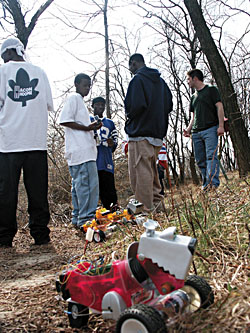 | Students from the Bronx River Art Center take their "feral" robot dogs for a "walk" in the great outdoors. |
Robotic dogs adapted by teen students in the Bronx, New York under the guidance of Yale engineering professor Natalie Jeremijenko, will be released on May 14 at the Cement Plant park on Westchester Ave. in the Bronx.
The "feral" robotic dogs will guide their teen partners to find the locations with the highest concentration of toxic pollutants in and around the Cement Plant park, which will soon be open to the public. The mechanical canines display the levels of contaminants they are "sniffing" by changing their movement.
"These students have been very quick at 'improving' these toys and understanding the social and political reasons for why we would like to re-think what 'toys' can be," says Jeremijenko, director of the Experimental Design Lab of the Department of
Engineering. "The students are much more interested in using them to explore their local environmental conditions than in following the user manual that comes with the original toys. We also have had fun doing some challenging engineering with these students."
Teens at the Bronx River Art Center (BRAC) collaborated with Jeremijenko and William Kavesh, an artist-in-residence at BRAC, to disassemble and rebuild the commercially available robotic toy dogs. The toys were "upgraded" by installing a new nose (data collection sensors) and a new brain that programs the dogs to "sniff out" contaminants in the environment, and by mechanically improving them so that they can traverse outdoor terrain. The students have transformed the dogs into what Jeremijenko describes as "feral robots."
The project is being piloted at BRAC as well as at several brown-field sites across the nation, including Baldwin Park in Orlando, Florida, The English Power Station in New Haven, Connecticut, and Snake River in Boise, Idaho.
The Bronx River experiment gives the students hands-on experience with mechanical, electronic and computing skills. Their efforts will also facilitate community-led monitoring of local environmental conditions, notes Jeremijenko. The goal of the project is to provide the opportunity for evidence-driven environmental discussion, she notes.
Gail Nathan, executive director of BRAC, says, "We expect our students to conclude the course with a better understanding of the type of chemical pollutants that affect our fresh water system, a familiarity with the range of sensors that can be used to measure the presence of toxic substances in the environment, and a greater sense of personal interest in their role as custodians of the environment."
-- By Karen Peart
T H I S
'Feral' robot dogs trace pedigree to Yale engineer W E E K ' S
W E E K ' S S T O R I E S
S T O R I E S![]()
 Review committee suggests changes to enhance education in Yale College
Review committee suggests changes to enhance education in Yale College
![]()
![]()
 'Feral' robot dogs trace pedigree to Yale engineer
'Feral' robot dogs trace pedigree to Yale engineer
![]()
![]()
 Yale tutors show students how 'America Counts'
Yale tutors show students how 'America Counts'
![]()
![]()
 University holding more 'teach-ins' on war with Iraq
University holding more 'teach-ins' on war with Iraq
![]()
![]()
 University issues health crisis alert for Yale travelers
University issues health crisis alert for Yale travelers
![]()
![]()
 Daily News alumni discuss how journalism has changed
Daily News alumni discuss how journalism has changed
![]()
![]()
 Actor Christopher Reeve advocates for stem cell research
Actor Christopher Reeve advocates for stem cell research![]()
![]()
 Dialogue about war in Iraq continues in campus events
Dialogue about war in Iraq continues in campus events![]()
![]()
 Exhibit traces career of experimental British photographer
Exhibit traces career of experimental British photographer
![]()
![]()
 Yale to train future medical leaders in re-focused program
Yale to train future medical leaders in re-focused program
![]()
![]()
 Study finds new drug holds promise in ovarian cancer treatment
Study finds new drug holds promise in ovarian cancer treatment
![]()
![]()
 Three students are awarded Goldwater Scholarships
Three students are awarded Goldwater Scholarships
![]()
![]()
 Truman Scholarships given to two potential leaders
Truman Scholarships given to two potential leaders
![]()
![]()
 Adviser to Peru's former president to present Downey Lecture
Adviser to Peru's former president to present Downey Lecture
![]()
![]()
 OBITUARIES
OBITUARIES Renowned historian and national parks enthusiast Robin Winks
Renowned historian and national parks enthusiast Robin Winks
![]()
 Frederic Holmes, a noted historian of science and medicine
Frederic Holmes, a noted historian of science and medicine
![]()
 Psychiatrist Dr. Ira Levine, former deputy director at YPI
Psychiatrist Dr. Ira Levine, former deputy director at YPI
![]()
 Edward Hoffman, had served as director of operations at Yale
Edward Hoffman, had served as director of operations at Yale
![]()
![]()
 Yale Entrepreneurial Society will co-host 'Innovation Summit'
Yale Entrepreneurial Society will co-host 'Innovation Summit'
![]()
![]()
 Book club event will feature a talk by Dr. Ben Carson
Book club event will feature a talk by Dr. Ben Carson
![]()
![]()
 Yale hosts fifth Powwow
Yale hosts fifth Powwow
![]()
![]()
 Discussion by scholars will examine the current state of affairs in China
Discussion by scholars will examine the current state of affairs in China
![]()
![]()
 Conference highlights graduate students' work . . .
Conference highlights graduate students' work . . .
![]()
![]()
 Brudner Prize winner explores the history of sexuality in talk
Brudner Prize winner explores the history of sexuality in talk
![]()
![]()
 Campus Notes
Campus Notes
![]()
Bulletin Home |
| Visiting on Campus
Visiting on Campus |
| Calendar of Events
Calendar of Events |
| In the News
In the News![]()
Bulletin Board |
| Yale Scoreboard
Yale Scoreboard |
| Classified Ads
Classified Ads |
| Search Archives
Search Archives |
| Deadlines
Deadlines![]()
Bulletin Staff |
| Public Affairs Home
Public Affairs Home |
| News Releases
News Releases |
| E-Mail Us
E-Mail Us |
| Yale Home Page
Yale Home Page